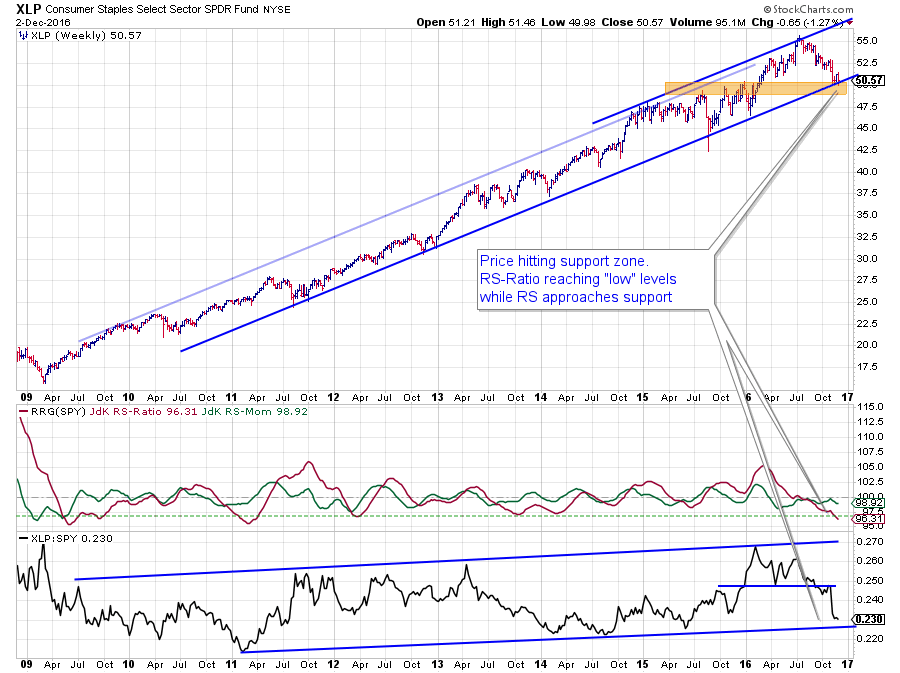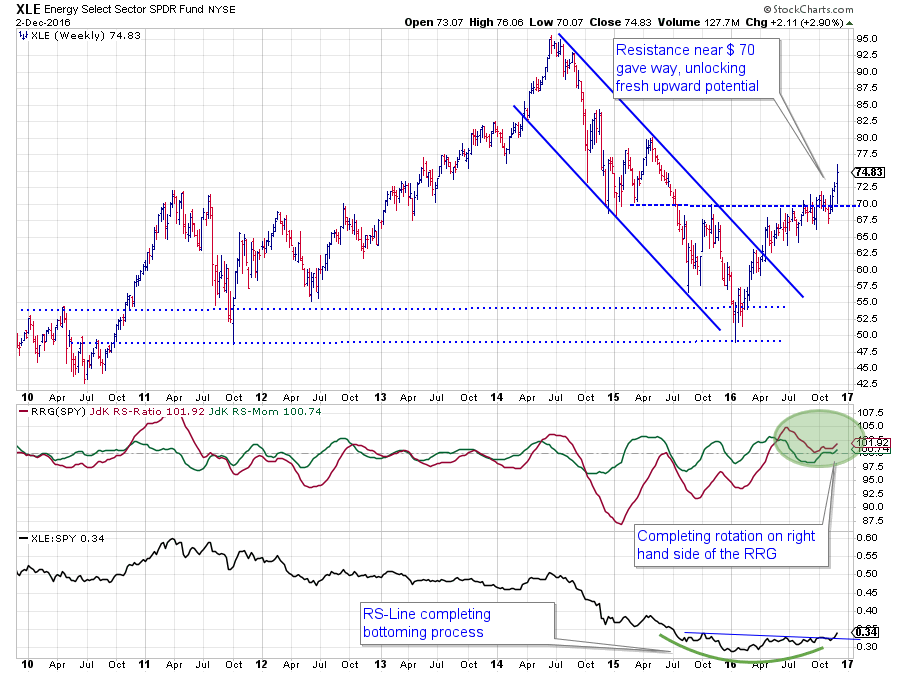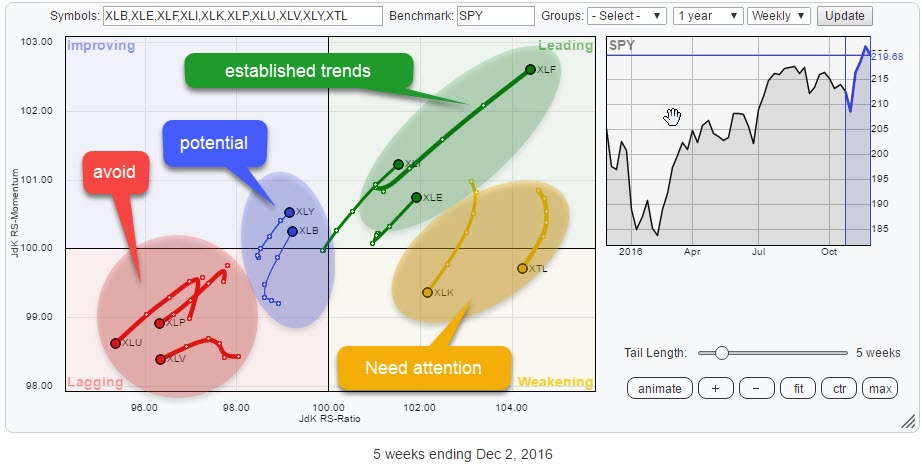 The Relative Rotation Graph above shows the rotational picture for US sectors. For a change the rotations are well defined and clearly visible, which immediately raises the question; " For how long?"
The Relative Rotation Graph above shows the rotational picture for US sectors. For a change the rotations are well defined and clearly visible, which immediately raises the question; " For how long?"
I will try to answer the question, but no-one ever said it was easy.. ;)
Summary
- Well defined sector rotation at the moment
- Avoid Utilities, Staples and Health Care as they push deeper into the lagging quadrant
- Watch Technology as it rotates inside the weakening quadrant
- Financials are still leading, but relative trend is getting mature
- Energy and Industrials inside leading quadrant offer potential
- Prefer Materials over Discretionary inside the improving quadrant
Quick scan
The first look at the RRG above reveals some well-defined sector rotations in US sectors.
Obviously, there is the Financials sector shooting up like a star inside the leading quadrant. It is for sure the leading, and most powerful sector in the US for the moment. Given the matureness of this (relative) trend, I would not chase it as the amount of upward potential decreases as the trend progresses. My previous post looked at the relative rotation of the financial stocks inside the DJ Industrials Index.
The two other sectors inside the leading quadrant seem to offer better value at the moment.
The three sectors inside the lagging quadrant are the opposite. Utilities, Staples, and Healthcare are all pushing lower on both axes, and all three are in established downtrends given their low readings on the JdK RS-Ratio scale. As all three are close together, there is not one that stands out as more mature. I prefer to avoid these sectors for the time being.
Inside the weakening quadrant and moving lower on both axes are Technology and Telecom where Technology is the heavyweight calling the shots. No need to worry yet but definitely the sector to keep an eye on for either further deterioration or a turn back up for the better and get on board again.
Upside potential seems present inside the blue shaded area in the improving quadrant. Consumer Discretionary and Materials are heading towards the leading quadrant. For the time being, my vote goes to Materials.
The lagging quadrant
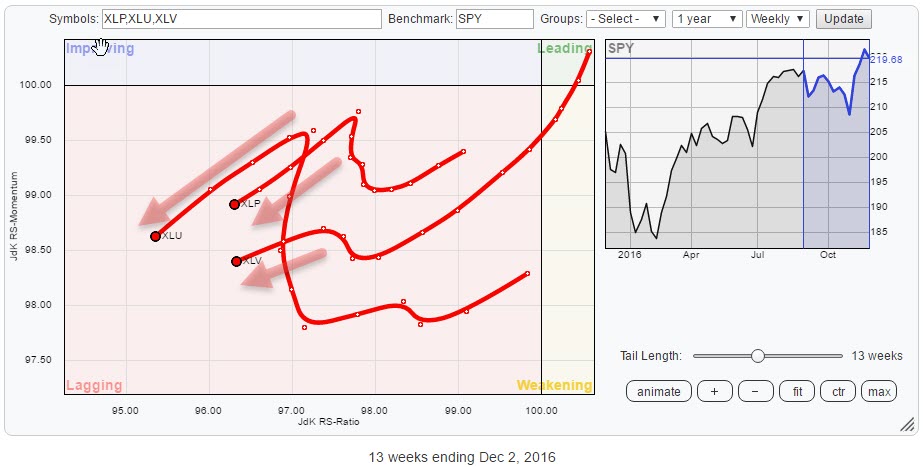 All three sectors inside the lagging quadrant are heading pretty much in the same direction. All are moving lower on both axes, indicating clear relative downtrends. The week-to-week distances between the observations (tail length) over the past few weeks are comparable which means that all three trends are moving at the same pace which makes it difficult to distinguish and make a more specific call for one or two of these three.
All three sectors inside the lagging quadrant are heading pretty much in the same direction. All are moving lower on both axes, indicating clear relative downtrends. The week-to-week distances between the observations (tail length) over the past few weeks are comparable which means that all three trends are moving at the same pace which makes it difficult to distinguish and make a more specific call for one or two of these three.
The best approach, for the time being, seems to avoid all three of them.
Utilities - XLU
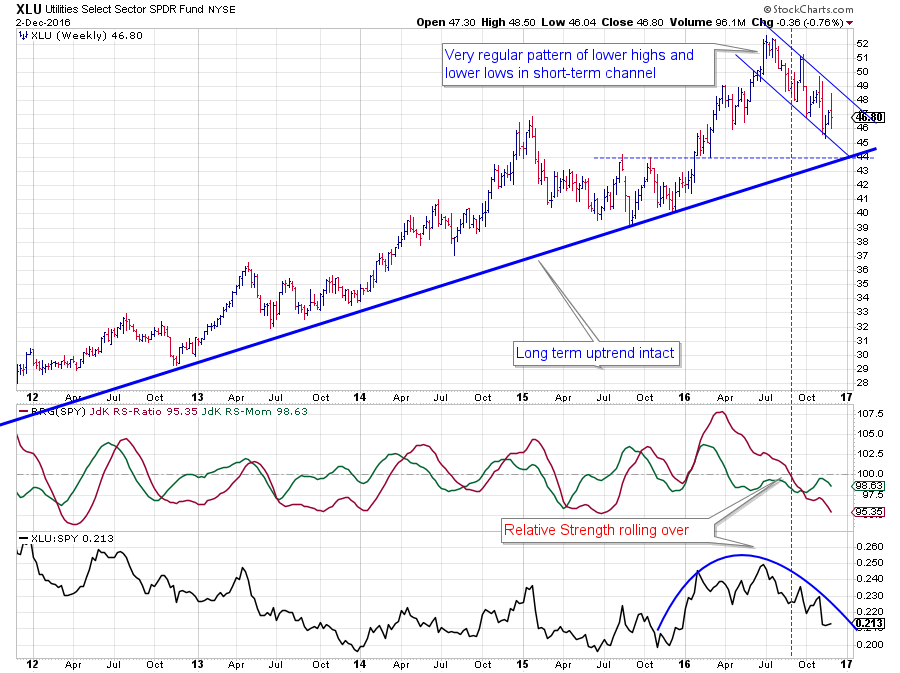 On the price chart, the utilities sector is still in a long-term uptrend following the rising support line that connects all the major lows over the past few years.
On the price chart, the utilities sector is still in a long-term uptrend following the rising support line that connects all the major lows over the past few years.
The relative charts, however, are telling a different story. After following the price chart higher in the first half of 2016, relative strength started to roll over around June/July when XLU started to rotate into the weakening quadrant. This weakness continued and finally pushed the utilities sector into the lagging quadrant where it now continues to push lower, underperforming the general market.
Both the RS-Rato line and the raw RS line are approaching levels that can be judged as "low" looking at the past few years. But before starting to call for improvement, I would like to see some sort of bottoming process to start.
This could very well happen when XLU reaches long-term support on the price chart. At the moment this level moves around $ 44 and edges gradually higher.
Consumer Staples - XLP
The second sector inside the lagging quadrant is Consumer Staples.
Here also the price chart is still showing an uptrend, a trend that is intact since early 2009. During this up-move relative strength has altered between some up- and downtrends. After a good run up in relative strength from mid-2015 to mid-2016, XLP started to move lower again from a relative point of view.
The raw RS-Line is approaching the slightly up-sloping support line while the JdK RS-Ratio line has arrived at "low" levels. This makes the current relative downtrend a mature one and probably too late to chase it.
Similar to the utilities sector above I would like to see the first signs of improvement in place before calling a turnaround or improvement.
Health Care - XLV
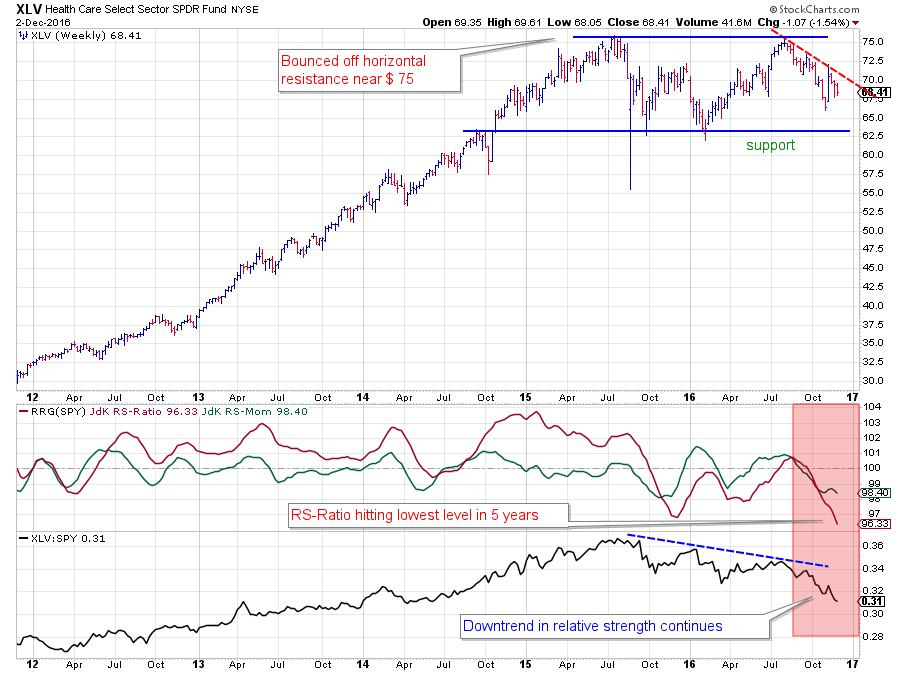 Health Care peaked around $ 75 back in 2015 and tested this resistance level again a few months ago. A broad trading range has developed, and XLV seems to be on track for a test of the lower boundary.
Health Care peaked around $ 75 back in 2015 and tested this resistance level again a few months ago. A broad trading range has developed, and XLV seems to be on track for a test of the lower boundary.
Relative strength started to weaken in the second half of 2015 and has recently accelerated lower as price started to come off its test of resistance.
On the price chart, there is room for a further decline towards levels around $ 62.50. The RS-Line is in a clear downtrend with little support in sight while the JdK RS-Ratio line is pushing to its lowest level in five years but looking at a longer term chart shows that RS-Ratio has moved well below 95 a number of times before, causing strongly negative rotations.
As said it is difficult to distinguish but this setup, probably makes XLV the weakest of these three.
The weakening quadrant
Information Technology - XLK
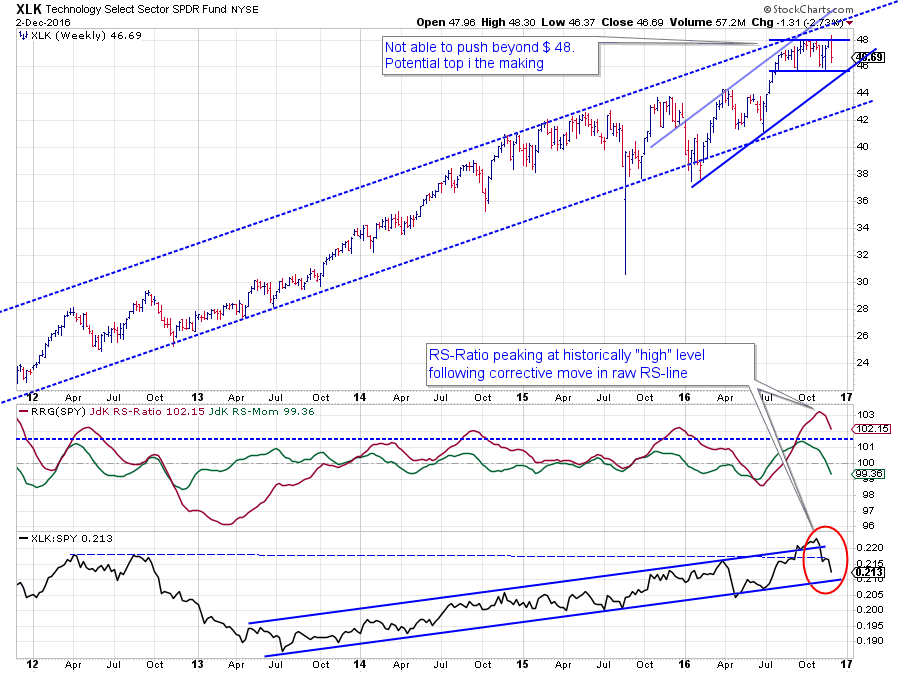 Inside the weakening quadrant, we find the technology sector which has been the sector leading the market from April to October.
Inside the weakening quadrant, we find the technology sector which has been the sector leading the market from April to October.
Over the past few weeks, the relative strength of XLK vs. SPY started to drop causing the JdK RS-Momentum line to fall below 100 and drag the sector into weakening. This drop below 100 marks a peak in the RS-Ratio line.
As you can see this peak has formed well above the dashed blue line in the chart which marks the historically "high" levels of RS-Ratio. Each time the RS-Ratio of XLK peaked above this level a pause or a decline in relative strength followed. This time looks no different.
As the RS-Ratio is still well above 100, it is certainly possible for technology to complete a rotation on the right-hand side of the plot and return to the leading quadrant without hitting lagging. A close look in coming weeks is needed as XLK is a heavyweight inside the S&P 500 and just as it was capable of leading the market higher it is also capable of dragging it down.
The leading quadrant
 The leading quadrant shows Financials, Industrials, and Energy all moving higher on both axes with XLF being the clear leader for the moment.
The leading quadrant shows Financials, Industrials, and Energy all moving higher on both axes with XLF being the clear leader for the moment.
The above RRG zooms in on the leading quadrant and shows the tails for the three sectors over 23 weeks.
Before moving over into leading Financials first completed a rotation from improving back into lagging and then moved into leading and started accelerating over the last four weeks.
Energy has been a leading sector since April - May when the bottoming process of its relative strength started. The loss of relative momentum, causing the rotation into weakening, began in July but has managed to keep RS-Ratio above 100 and complete the rotation on the right-hand side.
Industrials followed a somewhat similar path but crossed over into lagging briefly and very close to the benchmark before heading into the leading quadrant.
All three are pushing higher at a positive (0-90 degrees) heading, but Industrials and Energy seem to have the most upward potential left based on its much higher reading on the RS-Ratio axis.
Energy - XLE
The resistance level near $ 70 on the price chart was an important level for Energy. On the graph, you can see how the sector struggled with that level for almost two months. Once broken a few weeks ago XLE cleared the area rapidly and is now on its way to $ 80.
Relative strength versus SPY accelerated lower for XLE in the second half of 2014 and continued lower in a downtrend during 2015. The bottoming process started in the early days of this year and seems to be completing at the moment with the break above the slightly down sloping resistance line.
The RS-Ratio already picked up an improvement in relative strength in April and pushed the sector into the leading quadrant. As RS did not follow through right away, the sector lost some relative momentum and rotated into weakening.
The recent up-tick in RS, backed by the break of resistance in price, completed the rotation on the right side of the plot, pushing XLE back into the leading quadrant again. Both from a relative- and a price perspective there is now plenty of room for upside potential again.
Industrials - XLI
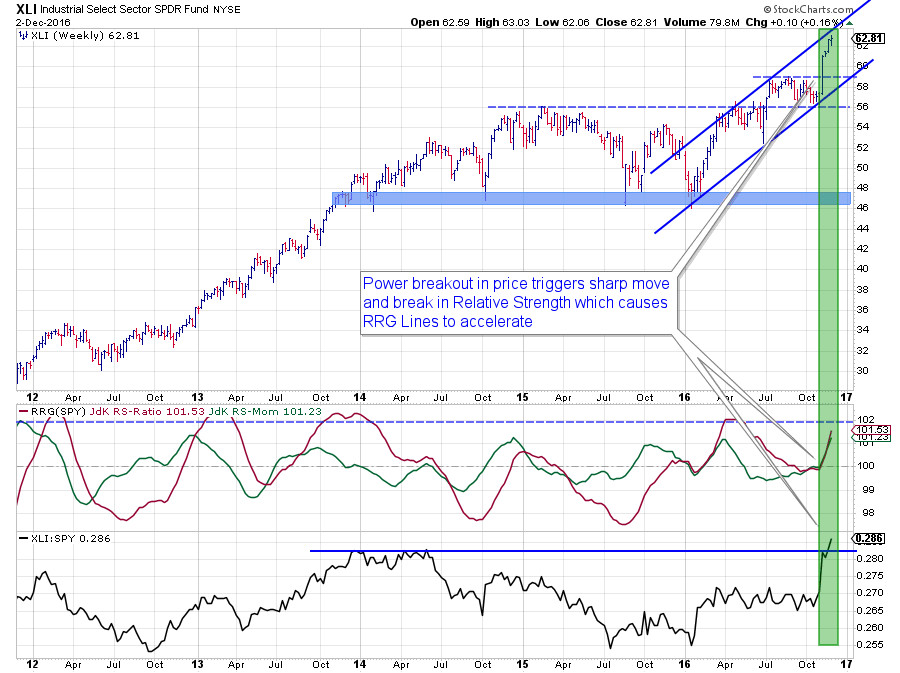 Industrials have taken the same rotational path as Energy with the only difference being a very short stint through lagging/improving before heading into leading.
Industrials have taken the same rotational path as Energy with the only difference being a very short stint through lagging/improving before heading into leading.
At the moment the chart of XLI is characterized by two powerful breakouts. The first in the price chart where resistance at $ 59 was convincingly broken, confirming the uptrend. As price is now hitting the upper boundary of the channel a bit of a correction is possible, but that should not hurt the bigger picture.
In the relative charts, the RS-Line powered through the horizontal resistance level offered by the early 2014 peaks. This break confirms the relative strength of the industrials sector at the moment. Just like price, relative strength has now new room for improvement, while the downside is protected by support offered by the former resistance level.
The improving quadrant
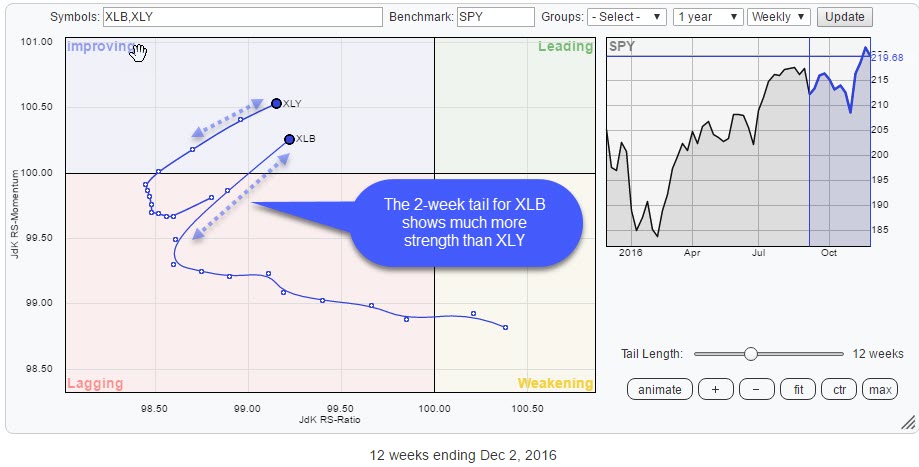 Two sectors are inside the improving quadrant at this moment, and both are at a positive heading towards the leading quadrant and close enough to assume that a normal rotation will get them there in a few weeks time.
Two sectors are inside the improving quadrant at this moment, and both are at a positive heading towards the leading quadrant and close enough to assume that a normal rotation will get them there in a few weeks time.
Based on the length of the tail, especially over the past two weeks, it seems that Materials have the lead over Consumer Discretionary for now.
Consumer Discretionary - XLY
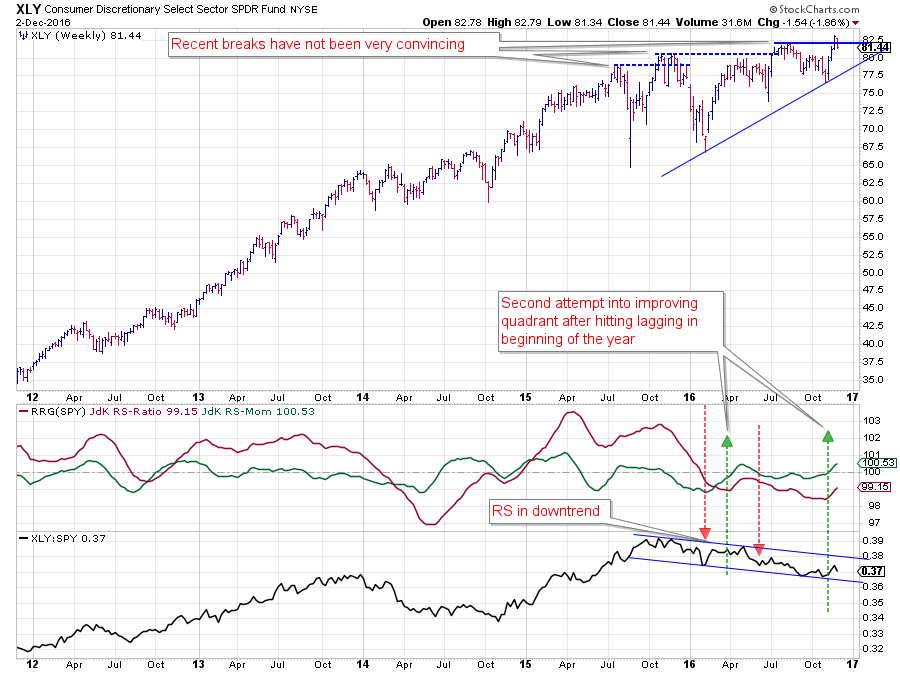 Since mid-2015 the discretionary sector has attempted to break higher a few times but never actually managed to get a solid follow through which I consider a risk as the buyers apparently are not prepared to take the sector (much) higher.
Since mid-2015 the discretionary sector has attempted to break higher a few times but never actually managed to get a solid follow through which I consider a risk as the buyers apparently are not prepared to take the sector (much) higher.
The recent break of two weeks ago looks to follow a similar pattern, a break and very quickly drop back below the breakout level again. As you know, failed breakouts are negative as they tend to reverse the initial "signal."
From a relative point of view, XLY is still in a downtrend against SPY which keeps RS-Ratio well below 100. With this short tail, the current pickup of momentum still inhibits the risk for a rotation on the left and back down to lagging again.
Materials - XLB
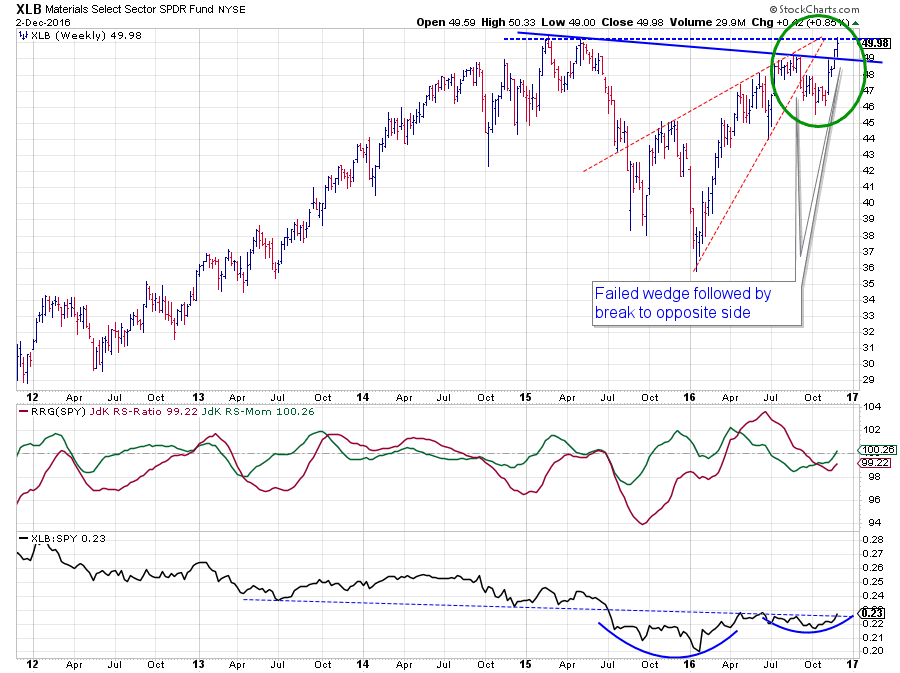 Materials is on a different path. The raw RS-Line is in the process of starting a new series of higher highs and higher lows and is just about to break above its, almost horizontal, resistance.
Materials is on a different path. The raw RS-Line is in the process of starting a new series of higher highs and higher lows and is just about to break above its, almost horizontal, resistance.
This improvement is showing up on the RRG-Lines where RS-Momentum has crossed above 100, and RS-Ratio is closing in on the 100-mark.
The fuel for a continuation of this relative improvement has to come from the price chart. Here also a "failed" breakout is visible but on the other side. The rising wedge was broken downward but did not get a follow through. Instead, price rallied, took out the down-sloping resistance, and is now pushing against horizontal resistance off of the early 2015 peak(s).
Combining the positions on the RRG, the length of the tails and the differences on the price and relative charts make me prefer Materials over Discretionary.
Julius de Kempenaer | RRG Research
RRG, Relative Rotation Graphs, JdK RS-Ratio and JdK RS-Momentum are registered TradeMarks by RRG Research
Follow RRG Research on social media:

